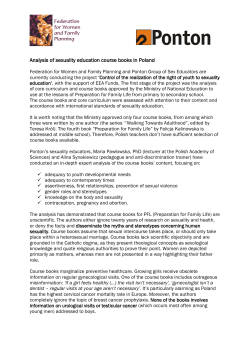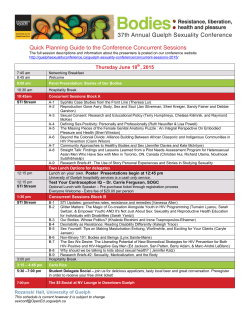
Preadolescence, an age suspended Definition
Marta Badoni Preadolescence, an age suspended Discussing preadolescence means looking at a subject matter that is short-lived but characterized by agitation, uncertainty and many unknowns. I would therefore like to begin with a definition. Definition Preadolescence is that period marked by body transformations which precede and prepare for puberty. It occurs approximately between the ages of 11 and 13, there being some variation between males and females and across geographical regions and cultures. It is a brief but intense period: it assumes that the so-called latency stage has come to an end, and it prepares for the beginning of adolescence. Preadolescence is therefore a suspended period, but one that lays the foundations for mental development. Puberty is that time when physical manifestations that mark sexual maturity take place: the girl has her first period and the boy his first ejaculation. The arrival of puberty changes the pace of sexuality, since intercourse between the sexes may now actually take place. Preadolescence may be defined as the psychical, psychological and sociocultural reaction to changes that precede puberty. With regard to psychic functioning, it is not a case, as Freud taught us, of continuing along a linear path, but of constantly remodelling mental functioning, which cannot but take into account past experience, present impulses and environmental responses. The preadolescent’s mental functioning, which is marked by ephemeral turbulence, obliges the analyst to continuously adjust throughout the therapy: he or she must cope with the young patient’s oscillation between desperate nostalgia for childhood, needing to feel grown-up and fear linked to an adolescent future that is approaching, with its various demands and the risk of acting upon thoughts. In comparison to adolescence, where the subject is put to the test in his relationship with the object and with matters of identity, preadolescence instead demands what can sometimes be a difficult confrontation with one’s own body. On the one hand, infantile sexuality is revived, and on the other, a body that is undergoing constant and predetermined transformation needs to be confronted: it is fundamental to future psychic development that the girl or boy accompany this transformation and be accompanied by it, without losing their sense of self continuity. Should this not occur, as Kafka so commendably described, they risk experiencing metamorphosis in the true sense of the word, no longer being able to recognize themselves in their newly acquired formation. Freud’s well-known statement on drives and their vicissitudes, in which he mentions the intensity of psychic work due to the close connections between drive and corporeity, is perhaps more relevant to preadolescence than to any other stage in life (see the quotation on the psychical work that is done because of the relationship with the body). Unlike early childhood, drives now emerge in a subject who is much freer and hence also more alone in dealing with these drives. It is clear how this can create a mixture of surprise, excitement and curiosity, but also a great deal of fear: “the way in which the prepuberal child projects himself in order to accelerate his entrance into adult life, or the strategy he uses in order to avoid such by seeking safety and protection with his parents or substitute parents, will significantly change the way pubertal processes develop”. (Birraux, 1990, author’s translation) Therefore, the “pre” that precedes adolescence does not merely indicate an advance time period, nor does it presume access to adolescence and its related tasks; what it does is put to the test mental functioning that is needed in order that the adolescent process may begin, and it also determines the outcome of this process. As pointed out by Bion, this kind of mental functioning requires a great deal of negative capability and rêverie – that is, an ability to hold a position of curious observation and waiting with regard to the succession of body changes – as well as transformation abilities. At work here shall be interference or pressure from the family, the group and/or the media, which may repress or accelerate early sexual pseudomaturity. The analyst must deal with the effects of a break in the linearity of physical development, social development (going from dependence to autonomy) and thinking quality. The child who enters adolescence thus finds himself in no man’s land: he will often be reminded that he is no longer a child, but at the same time that the level of autonomy and selfconfidence that have been reached are still too vague for autonomous social status to be conferred. Mental and intellectual functioning undergo gradual transformation, too. Piaget forwarded the concept of moving away from concrete thought towards formal thought: intelligence, he stated, no longer refers to concrete reality, perception no longer lending itself to the child as a yardstick for reality. According to psychoanalysts, this also brings about a change to the child’s system of representations. “It is a ‘second power’ logic that is capable of multiplying possibilities depending on how the individual uses it, as he discovers freedom and autonomy of thought with, as we shall see, ‘revolutionary’ consequences.” (Pelizzari, 2010, p. 46, author’s translation) It is up to the adolescent to give support to and make the most of both his autonomy and his freedom. Hormones - invisible agitators Prepuberty transformations are set in motion by complex neuro-hormonal mechanisms that are regulated by the hypothalamus and are sensitive to the influence of the Central Nervous System, the exact processes not yet being fully understood. These transformations force themselves upon the individual, who is subjected to them and who reacts to them. There is therefore a biologically determined element that prepares for and supports these transformations, but there is also – as Birraux sustains – a historically determined element regarding the way in which these transformations are experienced and integrated: this determinism is essentially that of the unconscious, and traces of experience and significant relationships are its main contributors. The production of a hormonal secretion that is as discreet as it is predetermined, therefore sets in motion pubertal body transformations and exposes the subject to drive and emotional turbulence he then has to deal with. For this reason, I feel it is useful to look at these sophisticated neuro-hormonal devices, i.e., the essential elements of this transformation, the organs involved in such and the hormonal mechanisms that determine it. The central problem during preadolescence is this start up of a process that, even if it is perfectly synchronized from the point of view of hormonal chemistry, is deeply disorganizing for the individual who experiences it. The girl and the boy have to come to terms with a changing body that has become foreign and mysterious, and at the same time they also have to deal with the activation or reactivation of particularly intense and disorganizing impulse activity. Two kinds of change occur: The maturation of primary sexual features that enable the male sexual apparatus and the female sexual apparatus to function. The appearance of secondary sexual features and physical changes that precede puberty. It is mainly the “secondary” features that are involved during preadolescence: their coming onto the scene makes a break with the childhood body representation and they impose themselves upon the boy and the girl with mysterious violence. These changes are the consequence of a subtle but powerful hormonal secretion that is regulated not only by complex feedback mechanisms (peripherally produced hormones regulate the pituitary gland secretion of gonadotropins – FSH and LH), but also by connections with the hypothalamus as well as with cortical areas. Pituitary gonadotropins (LH and FSH) are present in both sexes. LH seems to specifically act on the production of oestrogen by the ovary, as it does on the production of testosterone, the male hormone. In males, FSH contributes towards spermatozoon production and it stimulates ovary follicle development in females. The male hormone – testosterone – is secreted by the testicles and partly by the adrenal glands, and oestrogen (oestrone, oestriol, oestradiol) is secreted by the ovary. The ovary also produces progesterone, which is responsible for preparing the uterus for pregnancy. Oestrogen promotes the development of the breast in the girl, in the beginning being a sensitive bud which develops into the mammary areola. Breast development then continues with the development of the mammary gland. Oestrogen also promotes the development of the vagina, the uterus, the tubes, the labia minora, changes in mucous and the distribution of adipose tissue on the buttocks. Androgens, adrenals and ovarian hormones are responsible for the growth of hair on the pubes, on the labia majora and in the armpits. In boys, androgens promote the growth of the testicles and scrotum, an increase in the size of the penis, the appearance of pubic hair and changes to the skeleton. Oestrogen, a small part of which is produced by the adrenal gland, is responsible during this time for the production of fat around the mammary areola, often giving boys a vaguely effeminate look. Other important hormones also play a part during this period, such as thyroid hormones and growth hormones. What is important to keep in mind is that the discrepancy between the silence of hormone secretion and the intensity of body change it produces, obliges the individual within a relatively short space of time to come face to face with a perturbing unknown, and to find a space for it in his or her mind, as with representations of the self. Literature We would probably not be here discussing all of this if, over 100 years ago, Freud had not written the three essays on infantile sexuality. Several aspects of this important groundwork are that: sexuality is active from the beginning of life; and it is activated at sensitive areas of erogenous zones and orifices of the human body. Human sexuality manifests itself in various ways but more so at various different times: in early childhood, and then in preadolescence and adolescence. These two times are separated by a period of sexual latency to the benefit of diversified mental operations in the areas of sublimation or reaction formation. Although many have ascertained that the length of the latency period has been drastically shortened, I believe we should still consider that several acquisitions during latency are fundamental to guaranteeing a less traumatic passage through prepuberty. Even Freud himself was concerned about the latency period being prematurely interrupted: Experience further showed that the external influences of seduction are capable of provoking interruptions of the latency period or even its cessation, and that in this connection the sexual instinct of children proves in fact to be polymorphously perverse; it seems, moreover, that any such premature sexual activity diminishes a child's educability. (St. Ed., p 234) We can add today that as well as sexual seduction, seduction on the part of the adult and the social group has also been implicated, since it privileges conformity as opposed to being, thus preventing the child from gradually experiencing his reality. Freud began his essays on sexuality with the topic of perversion. This was a courageous act, especially at that time, but it was also a creative act that paved the way, as we shall see, towards future reflections: by softening the margins between normality and pathology, Freud promoted access to the richness of emotional play, to its creativity and to it undergoing transformation. “… tendencies to every kind of perversion can be shown to exist as unconscious forces and betray their presence as factors leading to the formation of symptoms. It was thus possible to say that neurosis is, as it were, the negative of perversion. In view of what was now seen to be the wide dissemination of tendencies to perversion we were driven to the conclusion that a disposition to perversions is an original and universal disposition of the human sexual instinct and that normal sexual behavior is developed out of it as a result of organic changes and psychical inhibitions occurring in the course of maturation”. (St. Ed., p. 231) The peak of these organic changes and their related psychical responses is preadolescence. Although Freud’s concern lay with puberty being successfully reached and genital drives consequently being successfully achieved, together with relative object investment displacement, he seemed to refer specifically to preadolescence in a short passage when he wrote: Finally it must be added that during the transition period of ‘puberty’ the processes of somatic and of psychical development continue for a time side by side independently, until the irruption of an intense mental erotic impulse, leading to the innervation of the genitals, brings about the unity of the erotic function which is necessary for normality. (St. Ed., p. 235) It is in fact this moving forward of the somatic and the psychic, side by side but relatively independently, that makes the preadolescent’s mental functioning so precarious, but interesting at the same time with regard to the reorganization of mental functioning. It is a time when the individual’s psychosomatic structure, self-cohesion and sense of continuity are put to the test. It is in Peter Blos’ (1958) work where we can next find specific focus on preadolescence. He looked at the consolidation of latency and how boys and girls diverge in manner during preadolescence. Furthermore, he looked not only at the role of parents during this time but at what the therapist is able to do together with the parents prior to working directly with the boy or girl, which I found particularly interesting, given the period in which this was written. Blos described the differences in behaviour between girls and boys as follows: Only with reference to the boy is it correct to say that the quantitative increase of the instinctual impulse during preadolescence leads to an indiscriminate cathexis of pregenitality. In fact, the resurgence of pregenitality marks the termination of latency for the male. At this time we observe in the boy an increase in diffuse motility (restlessness, fidgetiness), in oral greediness, sadistic activities, anal activities as expressed in coprophilic pleasures, ‘dirty’ language, the disregard of cleanliness, the fascination of odors and the skillful production of onomatopoetic noises. A fourteen-year-old boy, who started analysis at ten, put it aptly when he said retrospectively: ‘At eleven my mind was only on filth, now [age fourteen] it is on sex; it is very different.’ The preadolescent girl does not show the same features as the boy; she is either a tomboy or a little woman. (1958, p. 49) According to Blos, castration anxiety in the boy is mainly addressed to the archaic mother and it can lead to his protecting himself by having closer ties with his same sex, such as being part of a gang. Unfortunately, gangs, unlike groups, have been seen today to serve the purpose of reinforcing transgressive impulses as opposed to providing support for identity. In the girl, repression tends to get the better of pregenital impulses and the process of separation from the maternal figure is longer and more painful. In order to detach herself from the mother, the girl may prematurely seek refuge in the opposite sex with behaviour that is both aggressive and seductive at the same time. This is essentially a defensive form of pseudo-sexuality as opposed to regression towards a preOedipal mother. Today, the first sign of pregnancy continues to forewarn of not-insignificant problems for the social fabric. In writings from the English-speaking world, Moses Laufer (1976) developed the concept of the Central Masturbation Fantasy out of his reflections on adolescents and young adults …“the fantasy whose content contains the various regressive satisfactions and the main sexual identification”. (p. 4) According to Laufer, this is a universally present fantasy, whose power does not depend on whether the individual performs masturbation or not. During latency the content of this fantasy remains unconscious, but is expressed in a disguised form via daydreams, via the fantasies which accompany masturbation, or via games or makebelieve activities and relationship. In Laufer’s view, reactions to this fantasy during both latency and preadolescence are principally determined by reactions of the Super-Ego. Only when puberty has come to an end does the fantasy acquire new meaning, presenting the Ego with specific issues that are different from those that went before. These mainly concern the choice of object. Laufer believes that entering adolescence successfully depends on the preadolescent’s ability to “ward-off” the regressive drive of pregenital desires, otherwise he will end up considering masturbatory fantasy as a repeatedly overwhelming experience. It would instead be more useful during preadolescence to make masturbatory fantasy a: “‘trial action’… that is, as an autoerotic activity which helps to integrate regressive fantasies as part of the effort to achieve genital dominance.” (p. 5) We can see from these brief thoughts how Freud – when he is concerned about setbacks to the subject’s sexuality – and Laufer, both seem to wish that pre-adolescence could remain open in time; time enough to allow adolescence to be accomplished once necessary mental equipment has been acquired: that is, the integration of infantile sexuality with genital sexuality and the choice of object. On another point of view, French psychoanalysis has captured this need for “negative capability” (Bion) while working with preadolescence, as well as the ability to leave the advent of the object pending, so as to enable the preadolescent to negotiate with his set of drives. The concept of intersubjectivity is defended by Roussillon (2004), as long as the integration of the unconscious dimension of subjectivity with the drive and sexual problem is recognized: J’utilise le terme “intersubjectif” pour penser la question de la rencontre d’un sujet, animé de pulsions et d’un vie psychique inconsciente, avec un objet, qui est aussi un autre sujet, et qui lui aussi est animé par un vie pulsionnelle dont une partie est inconsciente. It is clear from this that the drive can no longer be thought of just as needing to be discharged, consideration needing to be given to the subjective message it carries and transmits as well. We therefore need to go back to Freud’s thoughts on trauma, which he continued to develop throughout his lifetime. The “object” was in fact part of the “project”, and it only appeared to be put to the side due to focus being placed on the economic problem in the traumatic neurosis and to child fantasies replacing the seduction theory. Indeed, it increasingly seems that from 1920 onwards, the psychology of the individual was in fact “social” psychology: the drive seeks both pleasure and the object at the same time. The drive therefore acquires the quality of a message, and it has an important place in human communication and related intersubjective exchanges. These messages may also be actions – it is worth remembering this in connection with preadolescents – and they take on a particular meaning when they occur within the analytic relationship. In the background, however, still lies the problem of hilphlosigkeit, i.e., helplessness. With regard to preadolescents in particular, attention needs to be paid to the effervescent and fragmentary nature of partial drives, the role of the analyst before such being first and foremost that of witnessing acrobatics which moves towards representation and differentiation. The former concerns the coming to be of infantile sexuality, and the latter the subjective appropriation of the me/not-me difference (moi/non moi) – this is the preadolescent’s main task. A 12-year-old boy who was caught up in problems of this kind came to my office one day in spring with a large flurry of pollen from nearby linden trees that were in bloom. As if it were the most natural thing to do, he asked me to gather up the pollen and put it all together, which is exactly what I did, without making any comment: it formed a small, white, tender ball, which I put in my drawer. After some time, the boy asked me what had happened to the ball, … I opened the drawer and showed it to him. He was happy. A flurry of pollen, a flurry of drives, and the search for a container. I believe that what the preadolescent needs at this time is the presence of an adult who can guarantee a sense of integration and self-continuity while the individual is waiting to manage this on his own. If the encounter with the other represents the challenge of otherness for the adolescent, we could say that (Campanile, 2003) for the preadolescent, the other represents his body, i.e., a perturbing object that is both familiar and foreign at the same time, and which puts the subject to the test regarding an experience of potential traumatic loss. It is the analyst’s task before all else to witness this anguish and to offer oneself as a stable reference point in order to guarantee the preadolescent the time he needs to reorganize his psychical contents. Such would include the change in his relationship with his parents as well as how he measures up to his peers. Factors in the running in preadolescent transformations I shall now go back to the themes I introduced at the beginning. I mentioned three factors that needed to be taken into consideration: the quality of past experience; dealing with present drives; and environmental responses. Given that these factors inevitably interweave, they cannot be treated separately. A longitudinal study (Chagnon et al., 2003) with 32 participants between the ages of 10 and 14 showed that the way in which children deal with latency and preadolescence is fundamental to moving on to adolescence. It seems that preadolescents who possess optimal obsessive protection move on to adolescence better than those who appear to be more mobile affectively speaking, but who are actually more labile and therefore more dependent on the relational context. By optimal obsessive protection, the authors intend latency defence functions that are reinforced by control mechanisms which balance the virulence of oedipal affects, good counterinvestment of libidinal and aggressive representations, and the implementation of sublimation activity. These considerations seem to confirm both Freud’s concerns regarding the ability to control affects, as well as Laufer’s assertions. Both seem to hope that a moment of suspension shall be granted to the deployment of partial drives, i.e., a sort of transformation period, so that the preadolescent, eventually influenced by the environment, will not “dive” into action on a sexual level. The environmental response seems to be fundamental: it mainly involves the pressure that the environment may apply in its creating expectations that are too high and which can easily lead to depressive reactions or breaks. It concerns equilibrium between drive and narcissistic organization that is constantly being re-fashioned. What the preadolescent seems to be asking for is a parent that can be discreetly present and non-intrusive, and who can therefore accompany him discreetly in his decisions. Not only may the adult’s glance carelessly precede the boy’s or girl’s awareness of changes they are undergoing, but it can also blind their ability to capture this awareness; much therefore depends on the tact the adult has in accompanying the boy or the girl towards recognition of their transformations. The point of equilibrium of environmental responses thus lies in the ability to see and to recognize, without trivializing and without intruding, unlike the case from an analysis with a young girl who remembers, ... when my mother bought me my first bra, size 0, she took it out in the kitchen, at lunch-time, together with the rest of the shopping... Size 0 clearly expresses the beginning of growth and its denial, as is the case when young girls are caught up in the early torments over the timing and the ways of resorting to a bra. In the above example, there is a mother who is unable to recognize her daughter’s need for privacy and so she becomes an accomplice of the girl’s denial and wavering. Unlike the Oedipal child, who often shows his sexuality in order to exorcize castration anxiety, the boy but more so the girl, when on the verge of sexual maturity, tends towards a secret and transgressive confrontation with her own sexuality. Another girl referred to offence at her elder sister’s comment: seeing her run about the beach without a bikini top on when there were the beginnings of transformation of her breast, her sister reprimanded her saying, “what are you doing running around with those two stings ...”. This is a blunt comment, one that highlights the aggressive and stinging side of preadolescent sexuality, thrusting confusion on to sexual attributes and reinforcing feelings of shame. At other times, it may instead be a peer’s look that abruptly places the preadolescent before a reality that is either minimized or denied. A man in analysis told me about going back to school after the summer break, when he was approximately 14 years old, and a boy from his class approached him and said, “you and I are now the tallest ones in the class”. This had been a revelation to him: it was only then that he had become aware of how conspicuously he had shot up over the summer holidays. From these brief examples, one can already see the reigning confusion and ambiguity, even in the adult representation of differences between the sexes, similarly to the different aspects of infantile sexuality: by throwing a bra onto the kitchen table together with the rest of the shopping, the young adolescent girl was thrown into the very same confusion she was experiencing, as opposed to being helped to find a place for her uncertainties; statural growth, which can be striking in males in particular, may be totally scotomized by parents, especially the mother, who is capable of addressing her son with ambiguous diminutive names (nickname?); peer interactions gradually act as a base against which aspects of the self are mirrored, but boys and girls may not always be ready for this. Mental suffering that accompanies these transformations can be very great and in order to be treated it requires psychic space that stretches out to include peers, teachers and the family. As for analysis, it must content itself with being reliable and discreet in cases such as these, gathering together what are often broken up accounts offered by the adolescents. It should not seek to be too hasty in interpreting succumbing conflicts, but pay attention towards safeguarding narcissistic levels of equilibrium and self-cohesion. These are the pain and resentment connected to separation, which are often so deep as to prevent boys and girls from separating “normally” from their domestic environment, in order to go to school, for example. I shall conclude by going back to the beginning, to the determining role of past experience in preadolescent dynamics. I would like to briefly underline one of the most worrying and frequently occurring phobic manifestations during preadolescence: school. We know that this symptomatology can emerge in childhood, too, but it is in preadolescence that it is particularly deep-rooted and difficult to treat. We come to realize that discreet symptoms concerning separation difficulty were present right from early childhood and the extent to which maternal anxiety or couple-related problems play a part in the emergence and duration of this symptom. Separation anxiety in the girl concerns family dynamics, too, especially when the mother is unable to sustain let alone think the event of her daughter distancing herself. I particularly remember a case of one mother who, when her daughter would finally be ready to leave the house to go to school, used to place a phone token in her hand (this was before mobile phones were introduced), in case her daughter wanted to phone her. It was fairly easy to show the mother the “ambiguity” this offer contained, as on the surface it confirmed the separation, but it also made it potentially impossible because of her very intervention. The direction of subsequent analysis (with the girl) was above all that of a “calm” but determined unfolding of regressive dynamics that tended to sully, provoke and sound out the object. The phobia gradually disappeared, but at every moment of change in social position (coming of age, marriage), I had to tend to this patient once more, and in the end, in adulthood, to send her to have analysis, which brought about new change and organization. I shall now leave some room for discussion and for any specific cases relevant to furthering the topics that have been raised here. I would just like to remember the impressive film (Lord of the flies) we were able to see some years ago which gave us such a vivid picture around the preadolescence and the issues about. 30th September 2012 References Birraux, A. L’adolescente e il suo corpo. Borla, Roma Blos, P. (1958). Preadolescent Drive Organization. J. Amer. Psychoanal. Assn., 6:47-56. Chagnon Jean-Yves, « Le pronostic à la préadolescence : une étude longitudinale », Psychologie clinique et projective, 2003/1 n° 9, p. 149-201. Campanile,P.(2003) Soggettivazione e “costruzione” della preadolescenza Freud, S. (1905) Three Essays on the Theory of Sexuality (The St. Ed. – 123-246) Laufer,M. (1976). The Central Masturbation Fantasy, The Final sexual organization, and Adolescence Pellizzari, G. (2010). La seconda nascita. Franco Angeli ed. Milano. Roussillon René, « La pulsion et l'intersubjectivité », Adolescence, 2004/4 no 50, p. 735-753. DOI : 10.3917/ado.050.0735
© Copyright 2025









